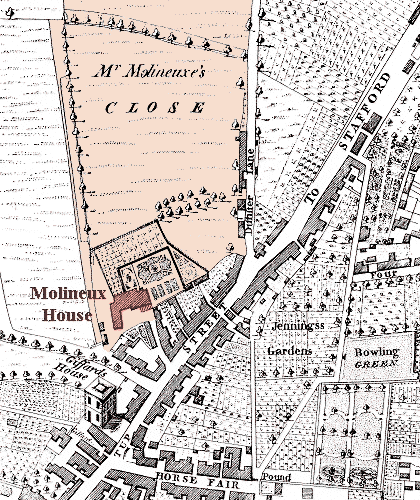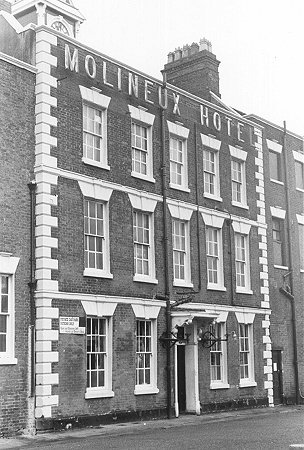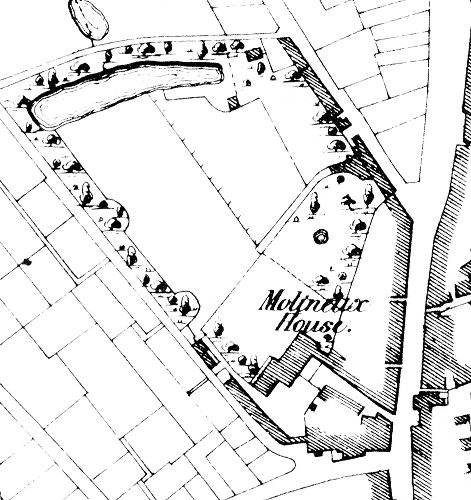|
The
Wolverhampton family and their new home
Richard and Hannah's son John, born
in 1675 settled in Wolverhampton during the early years
of the 18th century, and married Mary. They had five
sons and three daughters. John became an ironmonger,
supplying manufacturers with their raw materials, then
selling their finished goods. He became an extremely
successful and wealthy businessman. He began by selling
Black Country hardware such as brass and iron in Dublin,
then returned to Wolverhampton and set himself up as an
ironmaster in Horseley Fields, where he had two houses
with workshops at the back.
John and Mary’s fifth and youngest
son, Benjamin, became an ironmonger like his father, and
ran his uncle Daniel’s warehouse in Dublin, where he
stored and sold all kinds of goods such as locks,
hinges, tools, and saddler’s goods. He also sold
Birmingham-made steel toys. At the time, the trade
between Britain and the West Indies had greatly
increased, and so Benjamin exported many of his goods to
that region. He also imported Jamaica rum, and in 1775
opened a Jamaica rum warehouse in Wolverhampton, where
he also became a banker. He invested in the local
canals, and made many astute loans, becoming one of the
most successful businessmen in the area.
Another of their children, Thomas,
also became wealthy and built himself a large house in
Dudley Street, Wolverhampton, where the Marks and
Spencer store stands today. The house, which was built
in 1751, had imposing entrance gates, and an ornamental
garden that extended to Pipers Row.
Thomas married Margaret Gisborne on
the 5th August, 1732, at St. Paul's Cathedral, London.
They had nine sons and three daughters, most of whom
died in infancy.
The family residence in Tup Street,
Wolverhampton, known as Molineux House, came into the
possession of the family in 1744 after the death of the
original owner, John Rotton, who owed Benjamin Molineux
£700. The beneficiaries of his will (his wife, and his
business partner Richard Wilkes), agreed to sell the
property, and around 8 acres of surrounding land, to the Molineux family to pay off the debt.
Little is known about the original
property, which was probably built around 1720. The
Molineux family extended the house, and added a fine
rear extension, which looks even better than the main
façade. It is certain that by 1750 work had finished on
the house, and the rear formal garden, because they
appear on Isaac Taylor’s map, which was drawn during
that year. |
|

Molineux House and grounds in
1750. From Isaac Taylor's map. |
Benjamin’s mother Mary died in
1735, and his father John, died on 15th August, 1754. He
is buried in St. Peter’s Church, Wolverhampton.
Benjamin and his wife Elizabeth had
one son, George, and two daughters, Sarah and Mary.
Sarah married Lewis Clutterbuck of Bushbury, and Mary
married her cousin, Richard Molineux, a banker in
Wolverhampton. In the early 1750s Benjamin
contributed towards the building fund for St. John’s
Church, which opened in June 1760. Because of his
generosity, he qualified
as a trustee.
Benjamin had a black servant from
Sierra Leone, who was given as a present. He arrived in
England in 1766 at the age of 3, and was baptised George
John Scipio Africanus at St. Peter’s Church. After his
education he worked as a servant in the Molineux
household, and later became an apprentice at a brass
foundry, before moving to Nottingham. After Benjamin’s
death in 1772 he was looked after by Benjamin’s son,
George.
It seems that Molineux House became
too small for the family because Benjamin soon added
north and south wings. |
|
George, the only son of Benjamin
Molineux, succeeded his father in the family business,
and so became a banker, and an ironmonger, both at
Dudley and Wolverhampton. He also became a Staffordshire
magistrate, and High Sheriff of Staffordshire in 1791.
George was a partner in the family banking business of
Hordern, Molineux & Company, with James Hordern, and
also a shareholder in the ‘Wolverhampton Chronicle’ and
the ‘Staffordshire Advertiser’.
In the early 1790s he provided most
of the finance for the building of the Wyrley and
Essington canal which was built to transport coal to
Wolverhampton from the Cannock coalfields.
George Molineux married Jane
Robinson, and they had several children; George
Fieldhouse, Benjamin, John Edmondson, Richard, William
Hamilton, Charles Henry, Harriet, Sarah, and Sophia.
George Molineux died at Molineux House on 22nd
September, 1820. |
|
George Fieldhouse Molineux went to
Christchurch, Oxford, where he did an M.A. and became
the curate of Ryton, Shropshire, in 1798, a post which
he held for around 40 years. He was also the Prebendary
of Wobaston, in the Collegiate Church of St. Peter,
Wolverhampton, a Staffordshire magistrate, and one of
the trustees of Wolverhampton Grammar School. He died
the 30th September, 1840, and is buried at Ryton.
Another of the children, William
Hamilton became vicar of Sheriff Hales, Staffordshire,
in 1823. He was also curate of Acton and Bednall,
Staffordshire, and a prebendary of St. Peter’s Church,
Wolverhampton. He died unmarried on 29th September,
1831.
Charles Henry became a banker at
Dudley and Wolverhampton, and a Justice of the Peace for
Staffordshire and Worcestershire. After his death at
Bath on 11th February, 1848, the house passed on to his
brother, John Edmondson, who died on 23rd February,
1851.
The Molineux family finally severed
its connection with the house in the late 1850s. By then
the surrounding area had completely changed. The lovely
view across to St. Peter’s Church and the town centre
had filled-up with terraced streets and factories, and
even the views to the north were not what they used to
be. |

A 1970s view. Courtesy
of David Clare. |
|
Charles Edward Molineux, who was
born at Ryton Rectory, became the last family member to
own the house. In 1856 he moved to Kilsall, near Cosford,
and put the house and gardens up for sale. |

From the 1842 Tithe Map.
 |
|
 |
|
 |
Return to
part 1 |
|
Return to the
beginning |
|
Proceed to
part 3 |
|